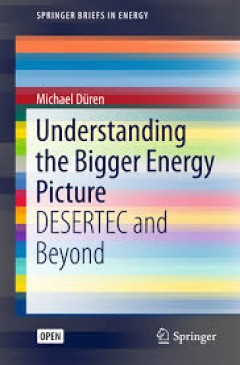Filter by

Understanding the Bigger Energy Picture : DESERTEC and Beyond
This book focuses on the global cycles of energy, water and carbon, which are not only the essentials of our main energy carriers, the fossil fuels, but are also the building blocks of life. The book offers an overview of the basic scientific facts and relationships that are needed to understand today’s energy generation and use, how they relate to global climate, the water cycle and other re…
- Edition
- -
- ISBN/ISSN
- 978-3-319-57966-5
- Collation
- XV, 110
- Series Title
- SpringerBriefs in Energy (BRIEFSENERGY)
- Call Number
- 333 DUR u

Fundamental Approaches to Software Engineering; 23rd International Conference…
Buku akses terbuka ini merupakan prosiding dari Konferensi Internasional ke-23 tentang Pendekatan Fundamental terhadap Rekayasa Perangkat Lunak, FASE 2020, yang berlangsung di Dublin, Irlandia, pada bulan April 2020, dan diadakan sebagai Bagian dari Konferensi Gabungan Eropa tentang Teori dan Praktik Perangkat Lunak, ETAPS 2020. 23 makalah lengkap, 1 makalah alat, dan 6 makalah kompetisi penguj…
- Edition
- -
- ISBN/ISSN
- 978-3-030-45234-6
- Collation
- 1 online resource (XIV, 552 Pages)
- Series Title
- -
- Call Number
- 005.1 WEH f

Foundations of Software Science and Computation Structures; 23rd Internationa…
Buku akses terbuka ini merupakan prosiding dari Konferensi Internasional ke-23 tentang Fondasi Ilmu Perangkat Lunak dan Struktur Komputasi, FOSSACS 2020, yang berlangsung di Dublin, Irlandia, pada bulan April 2020, dan diadakan sebagai Bagian dari Konferensi Gabungan Eropa tentang Teori dan Praktik Perangkat Lunak, ETAPS 2020. 31 makalah reguler yang disajikan dalam volume ini ditinjau dengan c…
- Edition
- -
- ISBN/ISSN
- 978-3-030-45231-5
- Collation
- 1 online resource (XV, 644 Pages)
- Series Title
- -
- Call Number
- 005.1 LAR f

Continuous Cover Forestry in Boreal Nordic Countries
This open access book compiles the latest research on continuous cover forestry in boreal forests, highlighting both the need for additional information and the exciting possibilities that this method presents. Experts in the field explore topics such as forest regeneration, genetic effects, wood production and yield, wood harvesting, forest damage agents, biodiversity, water effects, carbon cy…
- Edition
- -
- ISBN/ISSN
- 9783031704840
- Collation
- X, 292
- Series Title
- -
- Call Number
- -

Forest Bioeconomy and Climate Change
This edited open access volume explores the role of forest bioeconomy in addressing climate change. The authors put a particular focus on planetary boundaries and how the linear, growth-oriented economy, is coupled with climate change and environmental degradation. Biobased products and sustainable production paths have been developed, but how can they be scaled in order to lead to an economic…
- Edition
- -
- ISBN/ISSN
- 9783030992064
- Collation
- XVIII, 257
- Series Title
- -
- Call Number
- -

Climate-Smart Forestry in Mountain Regions
This open access book offers a cross-sectoral reference for both managers and scientists interested in climate-smart forestry, focusing on mountain regions. It provides a comprehensive analysis on forest issues, facilitating the implementation of climate objectives. This book includes structured summaries of each chapter. Funded by the EU’s Horizon 2020 programme, CLIMO has brought togethe…
- Edition
- -
- ISBN/ISSN
- 9783030807672
- Collation
- XXIII, 574
- Series Title
- -
- Call Number
- -

Weakly Nonlinear Systems: With Applications in Communications Systems
The open access book covers a large class of nonlinear systems with many practical engineering applications. The approach is based on the extension of linear systems theory using the Volterra series. In contrast to the few existing treatments, our approach highlights the algebraic structure underlying such systems and is based on Schwartz’s distributions (rather than functions). The use of di…
- Edition
- -
- ISBN/ISSN
- 978-3-031-40681-2
- Collation
- XIV, 371
- Series Title
- -
- Call Number
- -

3D Recording and Interpretation for Maritime Archaeology
This open access peer-reviewed volume was inspired by the UNESCO UNITWIN Network for Underwater Archaeology International Workshop held at Flinders University, Adelaide, Australia in November 2016. Content is based on, but not limited to, the work presented at the workshop which was dedicated to 3D recording and interpretation for maritime archaeology. The volume consists of contributions from …
- Edition
- -
- ISBN/ISSN
- 978-3-030-03635-5
- Collation
- XII, 237
- Series Title
- Coastal Research Library (COASTALRL, volume 31)
- Call Number
- 900 THR

Innovative Tools and Methods Using BIM for an Efficient Renovation in Buildings
This open access book describes a BIM-based toolkit that has been developed according to the latest research activities on building information modelling and semantic interoperability to optimize the building process. It highlights the impacts of using such new tools to fast renovation activities starting from the decision-making and design stages to the construction site management with the po…
- Edition
- -
- ISBN/ISSN
- 978-3-031-04670-4
- Collation
- VII, 121
- Series Title
- SpringerBriefs in Applied Sciences and Technology (BRIEFSAPPLSCIENCES)
- Call Number
- 620 INN

Developing Sustainable and Energy-Efficient Software Systems
This open access book provides information how to choose and collect the appropriate metrics for a software project in an organization. There are several kinds of metrics, based on the analysis of source code and developed for different programming paradigms such as structured programming and object-oriented programming (OOP). This way, the book follows three main objectives: (i) to identify ex…
- Edition
- -
- ISBN/ISSN
- 978-3-031-11658-2
- Collation
- XI, 77
- Series Title
- SpringerBriefs in Computer Science (BRIEFSCOMPUTER)
- Call Number
- 001 KRU d
 Computer Science, Information & General Works
Computer Science, Information & General Works  Philosophy & Psychology
Philosophy & Psychology  Religion
Religion  Social Sciences
Social Sciences  Language
Language  Pure Science
Pure Science  Applied Sciences
Applied Sciences  Art & Recreation
Art & Recreation  Literature
Literature  History & Geography
History & Geography